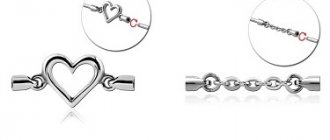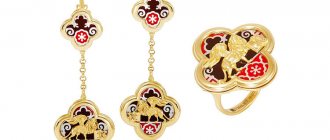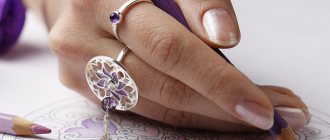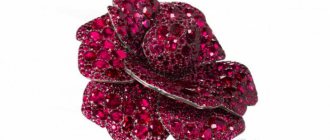International Jeweler's Day on January 31 is established for a reason: it is in January that goldsmiths register their hallmarks. The holiday itself was approved in 2008.
By the way, Jeweler's Day is celebrated twice in neighboring Russia: since 2010, there is also a separate Jeweler's Day in Yakutia - October 23. This respect for Yakut jewelry can be explained simply: this industry occupies a significant place in the economy of the region.
Able to engrave
Article on the topic The richest profession. January 31 is Jeweler's Day. The word “jeweler” was borrowed from the Turkic language and is translated as “one who knows how to engrave.” The profession itself is considered one of the most ancient. The first jewelry was found by archaeologists during the excavation of the pyramid Egyptian pharaoh Djoser (3200–2800 BC). Of course, in pre-Christian times, the decoration of stones and metals was much rougher than now, but even then jewelry was given a sacred meaning.
Story
The first jewelers appeared a long time ago. People have always loved to decorate themselves, and if you are a rich person, then you simply have to stand out from other people by putting on something so that everyone around you understands that you are not made with a finger.
The first precious jewelry was made from materials such as shells, animal teeth, flowers, berries, leaves, and in general from everything that was easy to get. And then people realized that polished stones can also be very beautiful. So people began to wear stone talismans around their necks. As time passed, people improved their skills and polishing, which was previously used only for ordinary stones, began to be used for precious gems. Later, people discovered metals, which made it possible to make more attractive jewelry, moreover, it was lighter and, therefore, more convenient.
The birthplace of jewelry is Ancient Greece. In Ancient Greece, the first jewelers began to carve stones and later made jewelry from precious metals.
Investigating the history of the appearance of jewelers in Russia, historians have come to the conclusion that jewelry making began in the ninth century. Jewelry in Russia has always been highly valued; in the royal domains, the crown, scepter and orb were always made of jewelry.
The holiday itself, International Jeweler's Day, arose in 2002 at a festival in Kostroma. This festival was called “Golden Ring of Russia”. And six years later, this holiday was established in Tashkent.
To become a jeweler you need good eyesight and patience.
The profession of a jeweler is considered extremely profitable and highly paid - precious jewelry and luxury items will always be in fashion, despite economic turmoil. However, this job is not for everyone. Firstly, in order to become a jeweler, imagination alone is not enough; knowledge and understanding of chemistry and mathematics are required. Secondly, performing complex work requires good vision.
Jeweler at work. Photo: RIA Novosti
Traditions
Traditionally, jewelers from all over the world hold various exhibitions of their jewelry on this day. Masters meet to exchange experiences, discuss and congratulate. Those interested can attend lectures on jewelry making, and also, importantly, see how jewelry is prepared in practice. Few specialists decide to conduct master classes, since this is far from the cheapest pleasure.
All events of this day are necessarily held in a solemn atmosphere. Everything should be beautiful and rich.
It is also important that many jewelry stores offer discounts and promotions on this day. Agree that this is a very good reason to please your loved one with a beautiful gift.
The patrons of Orthodox jewelers are Cosmas and Domian, and those of Catholic jewelers are Dunstan.
In the Orthodox faith, the patrons of handicrafts, which include jewelers, are Cosmas and Domian. Their memorial days are celebrated on July 14 and November 14. The patron saint of Catholic jewelers is Dunstan. There is a legend that the devil came to the saint’s forge and asked him to shoe him. The blacksmith recognized the evil one and therefore shoed the devil too painfully that he had to beg for mercy. Dunstan freed the uninvited guest, but on the condition that he would never cross the threshold of the place where there was a horseshoe.
January 31 is Jeweler's Day in Russia
Story
People first started talking about creating a professional holiday in 2002, at the international festival “Golden Ring of Russia” in Kostroma.
Six years later, at the festival of young jewelers in Tashkent, the organizers decided to submit an application to establish a holiday. The date - January 31 - was chosen as International Jeweler's Day due to the fact that it is in January that jewelers register their hallmarks. Also, since 2010, in the Republic of Sakha, Yakut jewelers have been celebrating their professional holiday on October 23 - in 2010, the President of Yakutia issued a corresponding decree. The birthplace of jewelry is Ancient Greece. It was here that jewelry made of precious metals with gems appeared for the first time in the history of mankind, and stone carving was also carried out for the first time. The Greeks used pearls and amber in their works. Outerwear was embroidered with small pearls.
Since ancient times, jewelry has demonstrated the status of their owners. So, back in the days when people wore necklaces made of shells and teeth of killed animals, the leader of a tribe could be identified by the most “rich” decoration.
Jewelry making in Russia
In Russia, jewelry making originated in the 9th-12th centuries. This was associated with the emergence of Kievan Rus and the Vladimir-Suzdal principality. In Rus', precious stones were considered a symbol of supreme power. They were especially valued when craftsmen framed them in gold and silver frames.
Gems from all over the world were brought to the royal storerooms. Only in the middle of the 17th century did the mining of Russian gems begin. Deposits of malachite were discovered in the Urals, and deposits of carnelian agates and jasper were discovered in Siberia. Russian jewelers at that time were very fond of combining bright sapphires and diamonds in one product. In the 18th century, the nobility became obsessed with diamonds. Under Peter I, Ural gems gained worldwide fame. In the mid-19th century, diamonds, emeralds, topazes, and rubies began to be mined in Russia.
"Jeweler of Kings, King of Jewelers"
Sometimes jewelers changed the taste of an entire era. This was Carl Faberge, who inherited the jewelry business from his father, but decided to go his own way. 26-year-old Faberge monitored fashion trends and personally selected craftsmen for himself. First of all, he was interested in Art Nouveau.
Carl Faberge at work. Photo: globallookpress.com
The elegant works of Faberge in 1882 at the All-Russian Art and Industrial Exhibition in Moscow attracted the attention of royalty - Emperor Alexander III and his wife Maria Feodorovna. Gradually, the whole world learned about the talent of a native of a family of Russified Germans with French roots. His fashion house supplied products to almost all the royal houses of Europe, Asia and Africa. At the same time, Faberge was an innovator, for which he began to be called the “Russian King of Jewelers.” Russian jeweler of kings." At the same time, Faberge often said: “If the whole value of expensive things lies in just a lot of diamonds or pearls, then they interest me little.”
In his works he used not only precious metals and gems, but even steel and tin. Thanks to Faberge, brooches made of Karelian birch, in which he interspersed with diamonds, came into fashion. In addition to his jewelry talent, Faberge also had, as they would say today, the abilities of a top manager. When making his jewelry, the jeweler counted on any wallet, which, of course, made it extremely popular.
Beliefs and legends associated with jewelers
According to Orthodox traditions, Saints Cosmas and Damian are considered the patrons of blacksmiths and jewelers. In their honor, the holiday is celebrated twice a year - on July 14 and November 14 according to the new style. These days are called Kuzminki.
In the Catholic Church there is a legend about Dunstan, the patron saint of blacksmiths and goldsmiths. One day the devil appeared in his forge and demanded to shoe his hooves. Dunstan recognized him and began to shoe him so hard that the devil asked for mercy in pain. The blacksmith released him only after the evil spirits promised that he would never again visit the place where there was a horseshoe - that is why this object is hung at the entrance to the house. Saint Dunstan's Feast Day falls on May 19th.
How is jewelry created?
Who comes up with the design of jewelry, and most importantly, how does the design then turn into a work of art? A Channel 5 photographer visited the Stieglitz workshop. There, the couple - blacksmith and jeweler Atilla and Maria Baltaev - in an interview with Channel 5, told how they make jewelry.
Video: Kristina Logvinenko, Aniya Bataeva for Channel Five
The jeweler demonstrated how she prepares her projects from the moment of creating a sketch to casting the mold. Most decorations are completed in one to two weeks. More complex ones can take months.
Jeweler is a hereditary profession
Most often, the profession of a jeweler is “passed on by inheritance” - there are often cases when, over the course of decades, or even centuries, the skill of cutting stones has been passed on from generation to generation. For example, a jewelry dynasty from the Moroccan city of Tiznit, whose representatives have been creating their famous products for many centuries.
Exhibits of the Faberge Museum in St. Petersburg. Photo: www.globallookpress.com
Interesting Facts
- The oldest jewelry is considered to be Nassarius shells, found in a Moroccan cave; they are 82,000 years old.
- Ancient Greece is considered the birthplace of jewelry. It was her masters who first performed stone carving.
- Gold and silver are too soft metals, and most jewelry is not made from them, but from alloys.
- A diamond is not the most expensive gemstone. This is considered to be alexandrite. It has a unique color: shades of green in daylight and lavender and crimson in artificial light. But natural reserves of alexandrite are extremely small. Its deposits are in Russia, Sri Lanka, as well as in India and Brazil.
- The most famous jeweler is Carl Faberge. He laid the foundation for a whole dynasty of jewelry masters.
- The most expensive of the famous “Faberge eggs” is the “Rothschild”, or “winter” egg. Made in 1902, it was bought in 2007 for $18.5 million. It is currently kept in the Hermitage.
- There is an opinion that synthetic stones are worthless. In fact, the only thing that distinguishes them is that they are grown in special laboratories. The structure and appearance completely coincides with a stone of natural origin, and only experienced specialists can distinguish them from each other.
- Source
The most famous and poorest jeweler
Perhaps the most famous jeweler is Carl Faberge - his name is familiar to people not interested in jewelry, and his works are highly valued by collectors. The St. Petersburg master created the first egg in 1885 for the wife of Tsar Alexander III , and the most expensive product of the Russian master Faberge was the egg, sold at auction for $18.5 million.
Despite this, the great master died in poverty - after the revolution of 1917, all of Faberge's property was arrested, and he himself had to leave the country.
History of the profession in Russia
The first finds of jewelry date back to the 9th century. The works of ancient Russian jewelers that have come down to us are distinguished by their richness of forms. We find chased frames of icons and Gospels, silver liturgical vessels, and jewelry. The craftsmen used techniques such as filigree, niello, enamel, embossing, and metal carving.
In the 17th century, gem mining began in the Urals. Grinding and cutting factories appeared, and from the 19th century - silver and gold factories. In the second half of the 19th century, the world famous jewelry house of Carl Faberge emerged. His products made of rock crystal, jasper, jade, lapis lazuli, quartz and other stones were supplied to almost all the imperial and royal houses of Europe.
Jewelry making is the art of processing precious materials and making jewelry, a type of decorative and applied art.
About the heroes of the occasion
Jewelry making is a complex, multifaceted craft that requires from a specialist not just special knowledge and skills, but also patience, perseverance, attention, and extraordinary precision.
Jewelers must have extraordinary knowledge not only in the artistic field. When working with metals and their alloys, various stones, the craftsman needs to perfectly know the properties and characteristics of the materials, and be able to visually assess the quality of the raw materials.
In this difficult creative task, the masters are helped by their patrons: for Catholics - Saints Eligius and Dunstan of Canterbury, for Orthodox - Cosmas and Damian.
The names of the masters of modern jewelry are known throughout the world.
Toasts
“Happy professional day to you, dear jewelers! Your job is to give beauty. I wish you inspiration, creative success, joy, good luck, a rich and bright life! Then the fruits of your labor will definitely be unique and will give a holiday to so many.”
“We congratulate the jewelers on their professional holiday and wish them to have as many beautiful things in their lives as they do at work. Let what is not gold be silver, let in your hands be exactly the jewel that you need more than anything in the world.”
“When they say “golden hands,” this is undoubtedly about the jeweler! Only a select few can create real works of art and elegant jewelry worthy of the most beautiful women with their own hands. And today we wish our jewelers inexhaustible inspiration, creative perfection and always excellent results from their painstaking work!
A gift to give to a craftsman on International Jeweler's Day
If you have a friend or relative who is involved in the jewelry business, then you will want to give a gift, and here you can highlight some ideas for a gift for a jewelry master.
Book. It may contain interesting information about jewelry, and it may also be a catalog of unusual jewelry. It is very good if the book or catalog is in a festive binding.
Portrait. Such a gift can make many people happy. It can be made in an unusual style. A person engaged in the creative field is able to appreciate such a gift, because it can decorate the walls of a workshop or his own jewelry store.
Sweets. Few people would not be delighted with a sweet surprise, and if you make sweets with the emblem of a master or company, then it is simply impossible not to be delighted with such a gift. After all, you can share this joy with others.
Yakut jewelers and cutters celebrate their professional holiday
YAKUTIA.INFO. In Yakutia, October 23 is the Day of Workers in the Diamond Cutting and Jewelry Industry. This holiday was established by the Decree of the President of Yakutia in 2009.
Today the republic is the only region of Russia that has such a professional holiday. This holiday became a tribute to those people who stood at the origins of one of the most promising industries in the republic.
In this regard, we have prepared 6 facts about the diamond cutting and jewelry industry of the Republic of Sakha:
1. On October 23, 1992, the first diamond in Yakutia weighing 0.27 carats was produced at the Suntar cutting plant
2. One of the leading and fastest growing companies in the Republic in the field of diamond cutting and jewelry is EPL Diamond. Sign "EPL. Yakut Diamonds" in any city in the world means that here you will find real Yakut diamonds. EPL is a long-term client of AK ALROSA and a member of the AlrosaAlliance program. ALROSA ranks first in the world in terms of diamond production in carats; its share in global production as of 2014 is more than 25%.
3. The largest diamond found on the territory of Yakutia is the “XXVI Congress” (332 carats) - found on January 14, 1981 by the shift of master T.N. Popov, is kept in the Diamond Fund of the Moscow Kremlin.
4. Perfectly cut “Burning Ice” diamonds are included in the “100 Best Products in Russia.” Only 1% of the world's rough diamonds can become Burning Ice diamonds from EPL Diamond. The main difference between Burning Ice diamonds and others is the ideal quality of all cut parameters. These are perfect diamonds that, when viewed through an idealscope, reflect a clear pattern of 8 “hearts” on one side and 8 “arrows” on the other.
5. Jewelry making among the Yakuts has been a hereditary occupation since ancient times. It passed from father to son along with tools and secrets. Their secrets included techniques of blackening, gilding and enameling.
6. And if the jewelry business in Yakutia has a solid, centuries-old history and traditions, then the cutting industry was formed before our eyes and with our participation. On October 23, 2015, EPL Diamond celebrates its 21st anniversary of successful activity in the Russian and global jewelry markets. The founder of the EPL company, Vice-President of the Guild of Diamond and Jewelry Manufacturers of the Republic of Sakha (Yakutia) Petr Fedorov congratulates the workers of the jewelry and cutting industry of Yakutia. “I wish you success in your difficult work! Health and happiness to you and your loved ones! Yes, these are difficult times, but I express my wish and confidence that we will all overcome this crisis together,” he addresses the jewelers and cutters of Yakutia.
For 21 years, EPL has been working to ensure that Yakut diamonds conquer the hearts of people all over the world!
In honor of Jeweler's Day and the company's birthday, EPL jewelry stores. Yakut diamonds"
They give fans of the brand phenomenal discounts of up to 61%.
Waiting for you!
Yakutsk, st. Oyunskogo, 4 tel.: (4112) 36-47-15
Lenin Ave., 9/3 tel.
Mirny, st. Sovestkaya, 3 tel.: (41136) 3-77-90
Lensk, st. Proletarskaya, 7 tel.: (4113) 2-41-22
Competitions
Prepare a gift Several teams of two people take part in the competition. Couples stand next to each other and hold hands. A gift box, wrapping paper, ribbons and other elements for decoration are placed in front of them. Couples must wrap the gift using only their free hands. The team whose work is the most representative wins.
Sleight of hand For the competition it is necessary to prepare a large number of objects that differ in size, size, and shape. For example: apples, nails, ballpoint pens, clothing items, kitchen utensils, wristwatches, children's toys, wrenches, etc. Participants in the competition are blindfolded and identical sets of objects are laid out in front of them. Contestants must feel and name all the things. The participant who completes the task faster wins.
Auction Participants in the competition are given funny gifts or trinkets: keychains, figurines, sets of sweets, a jar of canned cucumbers, etc. Participants in the competition must tell the audience about the item they received, presenting it as a unique and antique copy. Then an auction is held. The participant who manages to sell his lot for the highest price receives first place.
The history of the holiday International Jeweler's Day and its traditions
This holiday is considered quite young, because the idea of its creation arose only 17 years ago, and all thanks to the Golden Ring of Russia festival. It took place in the Russian city of Kostroma. And 11 years ago in the city of Tashkent, which is the capital of Uzbekistan, a festival was held where young professionals could demonstrate their talent, and it was then that the decision was made to establish such a holiday.
The traditions of this holiday are also associated with jewelry craftsmanship. Various exhibitions are held at which jewelers demonstrate their skills. Another tradition on this day is that master classes are held.
How do jewelers work?
From open sources
A jeweler's specialty involves processing stones and metals, drawing sketches, modeling and bringing ideas to life.
There are several specializations in the jeweler profession:
- installers;
- fixers;
- filigree workers;
- engravers;
- chainmen;
- artists;
- cutters;
- shareholders;
- grinders;
- enamellers;
- designers.
Jewelers can work in different places: both in small private workshops and in huge jewelry factories. Jewelers can also often be found in pawnshops, shops and expert bureaus.
Jewelers work with jigsaws, files, soldering irons, drills, pliers, hammers, drills, tweezers and other tools.
Famous jewelers
Let's take a look at some of the most famous names.
From open sources
First of all, of course, Carl Faberge. The founder of the “jewelry” dynasty, originally from St. Petersburg. His most recognizable works are his Easter jewelry eggs.
From open sources
Charles Tiffany. Founder of the American company Tiffani. Creator of the first jewelry catalog for retail sale.
From open sources
Louis-Francois Cartier. He became famous thanks to his bold ideas in abstract and futuristic styles.










